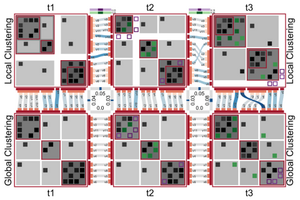Die Arbeitsgruppe zieht um!
Wir wechseln im Wintersemester 2021/22 an die Universität Bamberg. Ab 15. Oktober 2021 übernimmt Fabian Beck den dortigen Lehrstuhl für Informationsvisualisierung.
Neue Webseite der Arbeitsgruppe: https://www.uni-bamberg.de/vis
Publikationen
Publikationen der Arbeitsgruppe, die seit 2016 erschienen sind. Frühere Publikationen von Fabian Beck sind auf Google Scholar oder DBLP zu finden.

Art der Publikation: Beitrag in Zeitschrift
Visualizing Dynamic Hierarchies in Graph Sequences
- Autor(en):
- Vehlow, Corinna; Beck, Fabian; Weiskopf, Daniel
- Titel der Zeitschrift:
- IEEE Transactions on Visualization and Computer Graphics
- Jahrgang (Veröffentlichung):
- 22 (2016)
- Heftnummer:
- 10
- Seiten:
- 2343-2357
- Digital Object Identifier (DOI):
- doi:10.1109/TVCG.2015.2507595
- Volltext:
- Visualizing Dynamic Hierarchies in Graph Sequences (10.49 MB)
- Zitation:
- Download BibTeX
Kurzfassung
Graphs are used to model relations between objects, where these objects can be grouped hierarchically based on their connectivity. In many applications, the relations change over time and so does the hierarchical group structure. We developed a visualization technique that supports the analysis of the topology and the hierarchical group structure of a dynamic graph and the tracking of changes over time. Each graph of a sequence is visualized by an adjacency matrix, where the hierarchical group structure is encoded within the matrix using indentation and nested contours, complemented by icicle plots attached to the matrices. The density within and between subgroups of the hierarchy is represented within the matrices using a gray scale. To visualize changes, transitions and dissimilarities between the hierarchically structured graphs are shown using a flow metaphor and color coding. The design of our visualization technique allows us to show more than one hierarchical group structure of the same graph by stacking the sequences, where hierarchy comparison is supported not only within but also between sequences. To improve the readability, we minimize the number of crossing curves within and between sequences based on a sorting algorithm that sweeps through the sequences of hierarchies.
